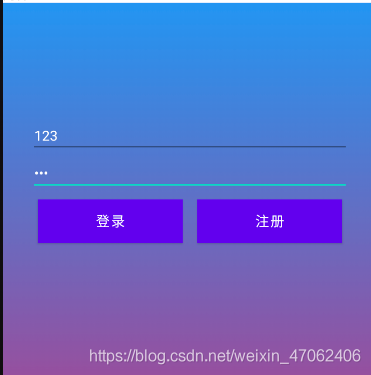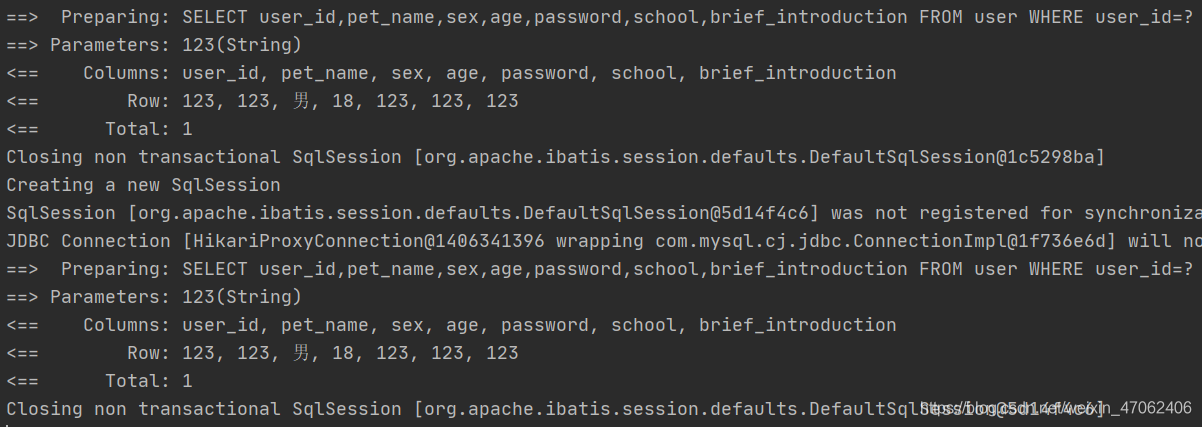Android 前后端交互 Android的简单前后端交互(okHttp+springboot+mysql)
会飞的种花家 人气:0前言
前阵子发现了个有意思又好用的框架——okHttp。由于课程设计需要,无意间发现了这个框架,打算利用此框架与后端交互,可以参考前后端分离的项目,把android当做前端,springboot当做后端,以下是二者的简单交互。
okHttp说明
(1)android网络框架之OKhttp
一个处理网络请求的开源项目,是安卓端最火热的轻量级框架,由移动支付Square公司贡献(该公司还贡献了Picasso)
用于替代HttpUrlConnection和Apache HttpClient
(2)okHttp优势
允许连接到同一个主机地址的所有请求,提高请求效率
共享Socket,减少对服务器的请求次数
通过连接池,减少了请求延迟
缓存响应数据来减少重复的网络请求
减少了对数据流量的消耗
自动处理GZip压缩
(3)OKhttp的功能
get,post请求
文件的上传下载
加载图片(内部会图片大小自动压缩)
支持请求回调,直接返回对象、对象集合
支持session的保持
android前端
逻辑控制:LoginActivity.java
import androidx.appcompat.app.AppCompatActivity;
import android.os.Bundle;
import android.util.Log;
import android.view.View;
import android.widget.Button;
import android.widget.EditText;
import android.widget.TextView;
import com.campus.book.R;
import com.campus.book.entity.User;
import com.campus.book.util.http.OKHttpUtil;
import com.google.gson.Gson;
public class LoginActivity extends AppCompatActivity {
//这个url可以通过cmd中输入 ipconfig IPv4 地址即为本地电脑的地址 8081为后端的端口号
private String baseUrl="http://192.168.xxx.1:8081";
private TextView tv=null;
EditText userId = null;
EditText pwd = null ;
Button login=null;
private Button registry=null;
@Override
protected void onCreate(Bundle savedInstanceState) {
super.onCreate(savedInstanceState);
setContentView(R.layout.activity_login);
setTitle("登录");
tv=findViewById(R.id.tv);
login = (Button)findViewById(R.id.login);
registry = (Button)findViewById(R.id.registry);
userId=(EditText) findViewById(R.id.userId);
pwd=findViewById(R.id.pwd);
login.setOnClickListener(new View.OnClickListener() {
@Override
public void onClick(View view) {
String id = userId.getText().toString();
String password=pwd.getText().toString();
User user=new User(id,password);
Gson gson=new Gson();
String json=gson.toJson(user);
String args[]=new String[]{"user","login"};
String res= OKHttpUtil.postSyncRequest(baseUrl,json,args);
Log.d("同步:",res);
res= OKHttpUtil.postAsyncRequest(baseUrl,json,args);
Log.d("异步:",res);
}
});
registry.setOnClickListener(new View.OnClickListener() {
@Override
public void onClick(View view) {
String args[]=new String[]{"user","getUser","123"};
String res= OKHttpUtil.getSyncRequest(baseUrl,args);
System.out.println("同步:"+res);
String args1[]=new String[]{"user","getUser","123"};
res= OKHttpUtil.getAsyncRequest(baseUrl,args1);
System.out.println("异步:"+res);
}
});
}
}
布局方式:activity_login.xml
<?xml version="1.0" encoding="utf-8"?>
<LinearLayout xmlns:android="http://schemas.android.com/apk/res/android"
xmlns:app="http://schemas.android.com/apk/res-auto"
xmlns:tools="http://schemas.android.com/tools"
android:orientation="vertical"
android:layout_width="match_parent"
android:layout_height="match_parent"
tools:context=".activity.LoginActivity">
<TextView
android:layout_width="match_parent"
android:layout_height="wrap_content"
android:id="@+id/tv"
android:text="内容:"/>
<FrameLayout
android:layout_width="wrap_content"
android:layout_height="wrap_content">
<ImageView
android:id="@+id/mainBg"
android:layout_width="wrap_content"
android:layout_height="wrap_content"
android:background="@drawable/login" />
<!--@drawable/login改成相应的背景图-->
<TableLayout
android:layout_width="350dp"
android:layout_height="match_parent"
android:stretchColumns="*"
android:layout_marginBottom="150sp"
android:layout_gravity="center" >
<TableRow android:layout_height="match_parent">
<EditText
android:id="@+id/userId"
android:layout_column="0"
android:layout_span="2"
android:hint="请输入手机号"
android:textColorHint="#FFFFFF"
android:textColor="#FFFFFF"
android:textCursorDrawable="@drawable/cursor_color"
android:textSize="15sp" />
</TableRow>
<TableRow android:layout_height="match_parent" >
<EditText
android:id="@+id/pwd"
android:inputType="textPassword"
android:layout_column="0"
android:layout_span="2"
android:hint="请输入密码"
android:textColorHint="#FFFFFF"
android:textColor="#FFFFFF"
android:textCursorDrawable="@drawable/cursor_color"
android:textSize="15sp" />
</TableRow>
<TableRow android:layout_height="match_parent">
<Button
android:id="@+id/login"
android:layout_height="wrap_content"
android:textColor="#FFFFFF"
android:background="#000000"
android:layout_margin="8dp"
android:textSize="15sp"
android:text="登录" />
<Button
android:id="@+id/registry"
android:layout_width="wrap_content"
android:layout_height="wrap_content"
android:textColor="#FFFFFF"
android:background="#000000"
android:layout_margin="8dp"
android:textSize="15sp"
android:text="注册" />
</TableRow>
</TableLayout>
</FrameLayout>
</LinearLayout>
其中,cursor_color.xml在drawable中。
<?xml version="1.0" encoding="utf-8"?>
<shape
xmlns:android="http://schemas.android.com/apk/res/android"
android:shape="rectangle" >
<size android:width="2dp" />
<solid android:color="@android:color/black" />
</shape>
springboot+mysql后端
(1)数据库
表user

(2)springboot中的controller层
如何搭建springboot工程就不再赘述了(如有需要,可留言,后续可发搭建教程),可自行参考其他文章。
@RestController
@RequestMapping("//user")
public class UserController {
@Autowired
private UserService userService;
//Gson gson= JsonBean.getGson();
static Gson gson=new GsonBuilder().serializeNulls().create();
@GetMapping("/list")
public List<User> list() {
return this.userService.list();
}
@PostMapping("/login")
public User login(String json){
User result=null;
User user=null;
User user1=null;
try{
user=gson.fromJson(json,User.class);
}catch (Exception e){
e.printStackTrace();
}
user1=userService.getById(user.getUserId());
if(user1!=null){//存在该账户
if(user1.getPassword().equals(user.getPassword())){//密码正确
result=user1;
}else{//密码错误
}
}else{//不存在该账户
}
return result;
}
@GetMapping("/getUser/{id}")
public User getUser(@PathVariable("id") Serializable id){
User user=userService.getById(id);
if(user!=null){//存在
}else{//不存在
}
return user;
}
}
运行(交互)效果

(1)点击“登录”按钮,发起post请求
android端

后端

(2)点击“注册”按钮发起get请求
android端

后端

这样就达到了前后端分离的效果,是不是很神奇!可以愉快的和小组成员分开进行开发啦!
在Android端中用到了个人结合需要编写的okHttp的工具类,可参考上篇文章:okHttp的get和post请求的简单封装与使用
加载全部内容